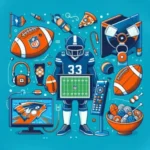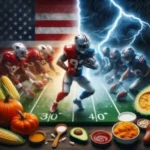As the crisp autumn air sweeps across stadiums filled with roaring fans, the thrill of game day is palpable, but there’s more to the excitement than just team rivalries and player matchups.
weather conditions play a crucial and often underestimated role in shaping the strategies employed on the football field. From biting cold winds that can alter a quarterback’s throw to rain-soaked fields that challenge even the most skilled players, the elements can dramatically influence not only how the game is played but also how teams prepare for battle. In this blog post, we’ll delve into the intricate relationship between weather patterns and American football strategies, exploring how coaches and players adapt to Mother Nature’s whims. Whether it’s the sunny skies of a late summer afternoon or the snow-laden chill of a winter showdown, understanding these game day elements can provide valuable insights into the unpredictable nature of the sport we all love.
1. Introduction to Game Day Elements and Their Importance
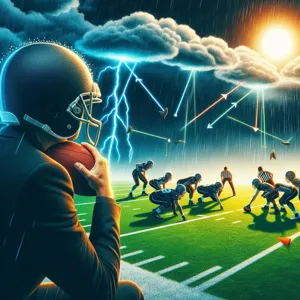
When it comes to American football, the excitement of game day is palpable—fans don their team colors, players warm up on the field, and the air buzzes with anticipation. However, one often-overlooked aspect that can significantly impact the outcome of a game is the weather. While strategies and plays are meticulously planned during the week, the elements can introduce a chaotic variable that forces teams to adapt on the fly. Understanding how weather conditions influence game strategies is crucial not just for coaches and players but also for fans trying to grasp the nuances of the game.
From sweltering heat that tests players’ stamina to torrential rain that complicates ball control, weather can affect everything from player performance to game tactics. For instance, teams may opt for a ground-and-pound running game in slippery conditions rather than risking a high-flying aerial attack. Similarly, wind can wreak havoc on passing plays, compelling quarterbacks to adjust their throws and receivers to recalibrate their routes.
As we delve into the various weather elements—temperature, precipitation, wind, and even the unpredictability of sudden weather changes—we will explore how coaches and players prepare for these challenges and how they can turn potential disadvantages into strategic advantages. By understanding the interplay between weather and gameplay, we can appreciate the brilliance of football strategies that evolve in response to Mother Nature, adding yet another layer of excitement to America’s beloved sport.
2. Understanding Weather Conditions in Football
Understanding weather conditions in football is crucial for teams aiming to optimize their performance on game day. The elements at play—sun, wind, rain, snow, or extreme heat—can significantly influence both strategy and execution. Coaches and players must stay attuned to these factors, as they can dictate everything from play selection to player positioning.
For instance, sunny and dry weather tends to favor passing games. Teams with strong aerial attacks might unleash their full offensive arsenal, relying on precise throws and swift routes. Conversely, when the skies open up and rain begins to pour, the game often shifts toward a more conservative, ground-and-pound approach. Slippery conditions can make the ball hard to handle, prompting coaches to lean on their running backs and tight ends, who can thrive in the muck and mire.
Wind is another critical element that can wreak havoc on a game plan. A strong gust can disrupt a quarterback’s rhythm, making long passes more challenging while simultaneously affecting field goal attempts. In high-wind situations, teams may opt for shorter, more controlled plays, prioritizing ball security and possession over deep shots downfield.
As temperatures drop, players must also contend with the physical toll of the cold. Frostbite and hypothermia become real concerns, and teams may adjust their strategies to minimize exposure to the elements—favoring quick plays to keep players moving and warm, or utilizing thicker, insulated gear that can help maintain body heat without sacrificing mobility.
Ultimately, a deep understanding of weather conditions allows coaches to craft strategies that not only accommodate the elements but also exploit their opponents’ weaknesses. By adapting their game plans to the unpredictable nature of the weather, teams can turn potential disadvantages into opportunities, ensuring they remain competitive regardless of the conditions on the field.
3. The Impact of Rain on Gameplay and Strategy
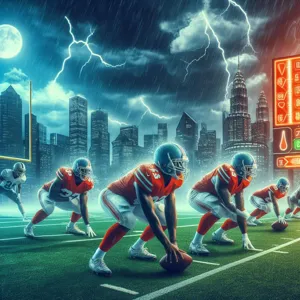
Rainy conditions can dramatically alter the landscape of an American football game, influencing everything from player performance to coaching strategies. When the skies open up and the field transforms into a slick, muddy battleground, teams must adapt their game plans to navigate the challenges posed by the elements.
One of the most immediate effects of rain is on the ball itself. A wet football becomes more difficult to grip, throwing accuracy can suffer, and receivers may struggle to secure catches. As a result, teams often lean towards a more conservative offensive strategy, opting for short, high-percentage passes and runs rather than deep throws that require precision. Coaches may also prioritize ball security, emphasizing the importance of holding onto the football to prevent costly turnovers.
Defensively, rainy weather can level the playing field, especially for teams with strong defensive units. A slippery field can hinder the speed and agility of offensive players, giving defenders an upper hand. In these conditions, defensive backs may play closer to the line of scrimmage to disrupt short routes, while linebackers focus on stopping the run as teams are less likely to attempt risky plays.
Moreover, rain can lead to a change in tempo. Coaches might choose to slow down the game, conserving energy and allowing their teams to adjust to the conditions. Clock management becomes crucial, with teams looking to maintain possession and minimize opportunities for opponents to capitalize on mistakes.
Ultimately, rain introduces an unpredictable element that challenges players and coaches alike, compelling them to think on their feet and adjust their strategies in real-time. Whether it’s a light drizzle or a torrential downpour, understanding how rain impacts gameplay can be the difference between a triumphant victory and a heartbreaking defeat on game day.
4. How Wind Affects Passing and Kicking Games
When it comes to American football, the impact of wind can be profound, influencing everything from passing accuracy to kicking distance. A swirling breeze can turn a straightforward pass into a challenge, making quarterbacks and receivers rethink their strategies. On a calm day, a quarterback can confidently launch the ball, trusting in the precision of their throws and the routes of their receivers. However, when strong winds whip across the field, even the most skilled passers must adjust their techniques. Throwing against the wind requires more power and a different angle, while throwing with the wind can lead to overthrows if the quarterback isn’t careful.
Receivers, too, feel the effects; they must be keenly aware of how the wind might alter the ball’s trajectory, potentially leading to missed catches or, worse, interceptions. Coaches often employ specific passing strategies on windy days, opting for shorter, more controlled passes that minimize the chances of the ball being affected by unpredictable gusts.
Kicking games are equally vulnerable to windy conditions. Placekickers rely heavily on their ability to gauge the wind’s direction and intensity before each kick. A strong headwind can dramatically reduce the distance of field goals, while a tailwind can propel a well-struck ball further than anticipated. Coaches might choose to forgo long-range attempts altogether, opting instead for safer plays that keep possession rather than risking a miss in challenging conditions.
Punts are also impacted; punters must adjust their angles and kick strength to ensure the ball lands in favorable territory, avoiding the risk of a return by the opposing team. Wind can even affect the hang time of punts, making it crucial for coverage teams to react quickly and efficiently.
Ultimately, understanding how wind influences gameplay is essential for teams looking to leverage the elements to their advantage. Adaptability becomes the name of the game as players and coaches strategize around the unpredictable nature of the weather, turning potential obstacles into opportunities for success on the field.
5. The Role of Temperature in Player Performance
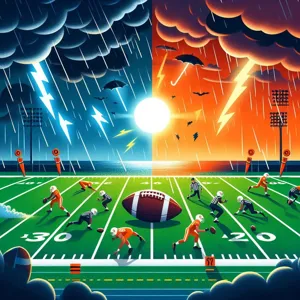
Temperature plays a pivotal role in shaping the dynamics of American football, influencing everything from player endurance to strategic decision-making on the field. On mild, sunny days, players often find themselves more energized and agile, allowing teams to execute high-tempo offenses that capitalize on speed and precision. This is particularly advantageous for teams that thrive on quick passes and dynamic routes, as players can operate at peak performance without the hindrance of excessive heat or cold.
However, as the temperature rises, so too does the risk of heat-related issues. Coaches must be vigilant about monitoring their players’ hydration levels and fatigue. In extreme heat, strategies may shift towards a more conservative approach, relying on a ground game that conserves energy and minimizes the risk of injury. This means heavier reliance on running backs and a more methodical play style, as teams aim to grind out yards while managing the physical toll of sweltering conditions.
Conversely, when temperatures dip, the challenges become equally pronounced. Cold weather can lead to stiff joints and decreased muscle flexibility, impacting a player’s ability to tackle, block, and sprint effectively. Teams may adapt by using thicker, insulated gear, but they must also account for how the cold can affect the grip on the ball, making passing accuracy more difficult. In these conditions, ground-and-pound strategies become crucial, as teams often prioritize short, controlled plays that minimize the risk of turnovers.
Ultimately, understanding how temperature influences player performance is essential for coaches and analysts alike. From training regimens to game-day preparations, the ability to adapt strategies based on the temperature can be the deciding factor between victory and defeat—illustrating just how intertwined weather is with the very fabric of American football.
6. Strategies for Cold Weather Games
Cold weather games in American football present a unique set of challenges that can drastically influence strategies on the field. When temperatures dip and the wind starts to bite, teams must adapt their gameplay to ensure they can maintain an edge against their opponents.
One of the most significant considerations for teams playing in frigid conditions is the choice of equipment. Players often opt for thicker gloves and thermal wear to combat the cold, impacting their grip and agility. Consequently, teams might prioritize a ground-and-pound running game over aerial attacks, as the risk of dropped passes and fumbled snaps increases with numb fingers and slick footballs. Coaches may also design plays that emphasize short, quick routes, allowing receivers to minimize exposure to the elements while still making effective plays.
In addition to alterations in play calling, the cold can affect player endurance and stamina. Coaches might implement more frequent substitutions, ensuring players remain fresh and capable of executing their roles effectively. This is particularly important for linemen, who exert considerable energy in the trenches. A well-timed rotation can keep players alert and physically prepared to respond to the demands of the game.
Weather conditions also dictate the importance of field position. Teams may become more conservative in their offensive strategies, favoring possession and field goal attempts over risky fourth-down conversions. Coaches recognize that maintaining momentum in cold weather is crucial; a single mistake can lead to costly turnovers that swing the game in favor of the opponent.
Finally, mental preparation becomes paramount in cold weather games. Coaches often emphasize the psychological aspect of playing in difficult conditions, encouraging players to embrace the challenge rather than succumb to the discomfort. Developing a tough mindset can not only enhance performance but also boost team morale, fostering unity in the face of adversity.
Overall, strategies for cold weather games are multifaceted, requiring teams to adapt their physical game plans while also focusing on mental resilience. By considering these elements, teams can better navigate the challenges posed by winter weather and emerge victorious, regardless of the icy temperatures.
7. Adapting to Heat: Hydration and Conditioning
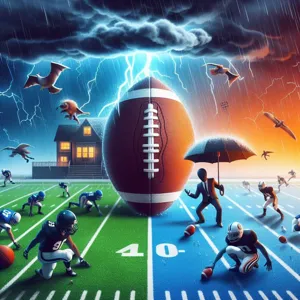
When it comes to American football, the sweltering heat of late summer and early fall can significantly impact game-day strategies. Coaches and players alike must prioritize hydration and conditioning to perform at their best, especially when temperatures soar. The body’s ability to regulate temperature is crucial, and dehydration can lead to fatigue, decreased performance, and even heat-related illnesses.
Teams often implement rigorous hydration protocols in the weeks leading up to the season, encouraging athletes to consume ample fluids both on and off the field. It’s not just about water—sports drinks rich in electrolytes are vital for replenishing the minerals lost through sweat. Players are often seen sipping from their water bottles during practice, but it’s just as important to focus on hydration during the intense heat of a game. Coaches might schedule more frequent water breaks, especially during timeouts or between quarters, to ensure their players remain hydrated.
Moreover, conditioning plays a key role in how well a team can adapt to the heat. Coaches often design training regimens that simulate game conditions, allowing players to acclimate to the rising temperatures. This might include running drills during the hottest parts of the day or incorporating high-intensity interval training that mimics the physical demands of a game while also challenging the players’ endurance in the heat.
Additionally, teams may adjust their strategies based on the weather forecast. For instance, if high temperatures are expected, they might favor shorter, high-tempo plays that keep the players moving without overexerting themselves. The goal is to maintain energy levels throughout the game while minimizing the risk of heat exhaustion.
Ultimately, successfully adapting to heat on game day requires a combination of proper hydration, conditioning, and strategic planning. Teams that prioritize these elements can maintain their competitive edge, even when the sun beats down mercilessly on the field. As the saying goes, “It’s not just about the game; it’s about how you prepare for it,” and when it comes to heat, preparation is everything.
8. Analyzing Historical Games Influenced by Weather
Analyzing historical games influenced by weather provides a fascinating lens through which to understand the strategic decisions made by coaches and players alike. Throughout the rich history of American football, weather has played an undeniable role in shaping the outcome of critical matchups, forcing teams to adapt their gameplay on the fly.
Take, for instance, the infamous “Ice Bowl” of 1967. Played in below-zero temperatures at Lambeau Field, the Green Bay Packers faced off against the Dallas Cowboys in what would become one of the most storied games in NFL history. The freezing conditions transformed the field into a slippery battleground, leading to a ground-heavy game plan that favored the Packers’ rugged running style. Coach Vince Lombardi’s decision to rely on a punishing rushing attack was a direct response to the icy conditions, ultimately culminating in a dramatic last-minute touchdown that clinched the championship.
On the other hand, consider the “Fog Bowl” of 1988, where visibility was so severely compromised that players struggled to see their own teammates. The Chicago Bears and the Philadelphia Eagles battled in a dense fog that enveloped the field, prompting both teams to adopt a conservative strategy focused on short, safe passes and a robust running game. The lack of visibility forced quarterbacks to rely heavily on their instincts and familiarity with their receivers, illustrating how weather can not only impact play styles but also elevate the importance of communication and chemistry.
These examples underscore how weather conditions can dictate game strategies, demanding creativity and adaptability from coaches and players. By studying the outcomes of these historical games, we can glean insights into how teams can prepare for various weather scenarios, adjust their game plans accordingly, and ultimately enhance their chances of victory come game day. Whether it’s the biting cold, relentless rain, or sweltering heat, understanding the nuances of weather’s influence on football can be a game-changer for teams looking to capitalize on every advantage.
9. Coaches’ Perspectives: Adjusting Game Plans
When it comes to American football, weather is more than just a backdrop; it’s a dynamic element that can dramatically influence the outcome of a game. Coaches, as the strategic architects of their teams, must continually assess weather conditions and adjust their game plans accordingly. This adaptability is crucial, as the success of a play can hinge on factors such as rain, wind, snow, or extreme heat.
Consider a scenario where a team is facing heavy rain. Coaches may decide to pivot from a pass-heavy strategy to a ground-and-pound approach, recognizing that a slippery ball can lead to missed catches and turnovers. By prioritizing the running game, they can control the tempo of the match while minimizing risks associated with aerial throws. This shift not only showcases a coach’s tactical flexibility but also highlights their deep understanding of the physicality of the game under adverse conditions.
Wind is another significant player in this strategic chess match. A strong gust can turn a routine field goal attempt into a high-stakes gamble, prompting coaches to reconsider their kicking strategy or even their decision-making regarding fourth downs. Similarly, when playing in snowy conditions, coaches often opt for simpler plays that focus on execution rather than complex routes, reducing the chance of players slipping or losing their footing.
Moreover, coaches must also consider the psychological impacts of weather on their players. Cold, rainy days can dampen morale, so instilling a sense of resilience and determination becomes essential. This often translates into motivational speeches that emphasize overcoming adversity, reinforcing team unity, and maintaining focus amidst external distractions.
In essence, the ability to adjust game plans based on weather conditions reflects a coach’s strategic acumen and adaptability. It is a testament to the intricate relationship between the elements and the game of football, reminding us that even the best-laid plans must remain fluid in the face of nature’s unpredictability. As fans, we can appreciate not just the athletic prowess on the field but the brilliant tactical minds working tirelessly from the sidelines, crafting strategies that ebb and flow with the changing skies.
10. Player Adaptations: Gear and Mental Preparation
When it comes to American football, the weather can drastically alter not just the game plan but also how players physically and mentally prepare for the challenges that lie ahead. Adapting to the elements is crucial, and teams that excel in doing so often find themselves at a significant advantage.
**Gear Adaptations**
The first line of defense against adverse weather conditions is the gear. In rainy or snowy conditions, players often swap out their standard cleats for specialized footwear designed to provide better traction on slick surfaces. These cleats often feature longer spikes to dig into the mud or snow, preventing slips and falls that can lead to injury or lost yardage. Quarterbacks may opt for gloves with grip-enhancing materials to ensure they maintain control of the ball during wet conditions. Likewise, receivers and running backs might choose gloves that allow for better ball handling, even in the most challenging of weather.
For colder games, layering becomes essential. Players often wear thermal gear under their uniforms to retain body heat without sacrificing mobility. Coaches may also implement strict protocols regarding hydration, recognizing that players can still suffer from dehydration in colder temperatures due to the dry air and exertion levels.
**Mental Preparation**
Equally important is the mental aspect of preparation. Coaches and players alike must adjust their mindsets to embrace the conditions rather than shy away from them. This often includes visualizing scenarios that can occur during the game based on weather variables, such as making quick decisions in the midst of a downpour or adapting to unpredictable wind patterns.
Team huddles may take on a different tone when weather issues are at play, focusing on resilience and adaptability. Players are encouraged to build a collective mentality that emphasizes unity and perseverance, reminding each other that regardless of the elements, the game must go on.
Ultimately, the intersection of gear and mental preparedness forms a crucial part of a team’s strategy when faced with challenging weather conditions. Teams that successfully integrate these adaptations can turn potential disadvantages into strengths, leveraging the unpredictability of the weather to create a game plan that not only withstands the elements but thrives in them.
11. Case Studies: Iconic Games Affected by Weather
When it comes to American football, few factors can alter the dynamics of the game quite like the weather. Over the decades, several iconic matchups have been profoundly shaped by weather conditions, leaving a lasting imprint on the sport’s history. Let’s delve into a few memorable case studies where the elements took center stage, influencing strategies, player performances, and ultimately, the outcomes of the games.
One prime example is the infamous “Ice Bowl” of 1967, where the Green Bay Packers faced off against the Dallas Cowboys in sub-zero temperatures at Lambeau Field. With the mercury plunging to -15°F (-26°C), players were forced to adapt to the brutal cold, leading to an emphasis on ground game strategies over passing. The Packers’ coach, Vince Lombardi, famously relied on a powerful running attack, culminating in a last-minute touchdown that secured Green Bay’s victory and a trip to the Super Bowl. The frigid conditions not only tested the players’ endurance but also showcased the mental fortitude required to succeed in such extreme circumstances.
Fast forward to Super Bowl XLVIII in 2014, where the Seattle Seahawks faced the Denver Broncos in a game played at MetLife Stadium in East Rutherford, New Jersey. Rain was in the forecast, but it was the wind that played the most critical role. The Seahawks, known for their aggressive defense and unique home-field advantage, utilized the windy conditions to their favor, disrupting the Broncos’ passing game. Quarterback Peyton Manning struggled to connect with his receivers, leading to an unexpected 43-8 blowout. The wet, windy weather not only influenced play-calling but also highlighted how crucial adaptability is for success at the highest level of competition.
Another compelling case is the “Snow Game” of 2013 between the Philadelphia Eagles and the Detroit Lions, where a blizzard blanketed Lincoln Financial Field. With snow accumulating rapidly, both teams had to adjust their strategies on the fly. The Eagles, with their dynamic running game, thrived in the conditions, ultimately winning 34-20. This game underscored how weather can level the playing field, making every yard gained a hard-fought battle and showcasing the sheer willpower of the athletes involved.
These case studies serve as a reminder of how weather can dramatically alter the course of a game, compelling teams to rethink their strategies and adapt to the unpredictable elements. By studying these iconic encounters, coaches and players can learn valuable lessons about preparation and resilience, ultimately improving their chances of success in future contests. As the old adage goes, “It’s not just the game; it’s how you play it in any weather.”
12. The Science Behind Weather Forecasting for Game Day
Understanding the science behind weather forecasting for game day is crucial for teams looking to maximize their performance on the field. In the world of American football, where every play can hinge on minute details, accurate weather predictions can provide a competitive edge. As game day approaches, teams employ a combination of advanced technology and expert analysis to gauge the environmental conditions they will face.
Meteorologists utilize sophisticated models that take into account various atmospheric factors—temperature, humidity, wind speed, and precipitation. These models are constantly updated in real time, allowing teams to track any shifts that could impact gameplay. For instance, a sudden drop in temperature might affect how players handle the ball, while strong winds could alter passing strategies.
Additionally, teams often have access to localized weather data that provides insights specific to the stadium’s microclimate. For example, a game played in an open-air stadium might be significantly influenced by the terrain and surrounding structures, which can create unexpected wind patterns or localized rain showers.
To further refine their strategies, coaching staff may also analyze historical weather data from previous games played under similar conditions. This information helps them anticipate player performance and adjust their game plans accordingly.
Ultimately, the intersection of meteorology and football strategy emphasizes the importance of being prepared for all elements that nature may throw their way. In this high-stakes environment, the ability to accurately forecast weather conditions can mean the difference between victory and defeat. By leveraging scientific insights, teams can not only prepare physically for the game but also strategically to outmaneuver their opponents, proving that in football, preparation is just as vital off the field as it is on.
13. Future Trends: Technology and Weather Monitoring
As we look to the future of American football, technology and weather monitoring are set to play an increasingly pivotal role in shaping game strategies. With innovations in data analytics and real-time weather tracking, coaches and players can gain a competitive edge by adapting their game plans based on rapidly changing conditions.
Imagine a scenario where a team, equipped with advanced weather monitoring tools, receives instant updates about sudden rain showers or wind gusts just moments before kickoff. This information allows them to adjust their offensive and defensive strategies on the fly. For instance, a team that typically relies on a strong passing game might pivot to a ground-and-pound approach if heavy rain is predicted. Conversely, if temperatures soar, teams may opt for shorter, quicker plays to minimize fatigue and maintain player stamina.
Moreover, wearable technology is revolutionizing player performance under varying weather conditions. Sensors embedded in uniforms can provide real-time feedback on players’ physical responses to heat, humidity, and cold, allowing coaching staff to manage player workloads more effectively. This data can inform decisions about substitutions, hydration strategies, and overall game tactics, ensuring that players are performing at their best, regardless of the elements.
As weather technology becomes more sophisticated, we can expect to see even more nuanced strategies emerge. For instance, teams might employ predictive analytics to simulate different weather conditions during practice, preparing players for any scenario they might face in an actual game. The integration of augmented reality tools could also allow coaches to visualize how their strategies would play out under various weather scenarios, enabling them to make data-driven decisions that enhance their chances of victory.
In this evolving landscape, the intersection of technology and weather monitoring is not just about gaining an advantage—it’s about rethinking the very essence of strategy in American football. As teams embrace these innovations, the game will continue to transform, making it more dynamic and exciting for players and fans alike. The future of football may very well rely on how well teams can adapt to the unpredictable whims of nature, and those who harness the power of technology will undoubtedly lead the way.
14. Conclusion: Embracing the Elements for Success
In the world of American football, the weather is more than just a backdrop; it’s a formidable player that can dictate the outcome of a game. As we’ve explored throughout this post, teams that embrace the elements rather than fear them often find themselves with a competitive edge. From how players adjust their strategies to account for wind and rain, to the meticulous planning that goes into selecting the right gear, understanding the weather can be the difference between victory and defeat.
Coaches and players alike must cultivate a mindset that welcomes the unpredictable nature of the game. A well-prepared team can turn a rainy day into an advantage, using slick conditions to their benefit by implementing a ground game that takes advantage of opponents’ struggles with footing. Conversely, teams that underestimate the impact of temperature or wind can find themselves outmatched, unable to execute their game plan effectively.
Moreover, the mental aspect of playing in adverse conditions cannot be understated. Teams that foster resilience and adaptability in their players build a culture of confidence, equipping them to handle any situation that arises on game day. The most successful teams are those that continuously adapt, refining their strategies not just based on their strengths, but also in response to the weather’s whims.
As we look to the future of American football, it becomes clear that embracing the elements is not merely a strategy, but an essential philosophy. Coaches and players must remain vigilant, studying weather patterns and learning from past games to transform challenges into opportunities. Ultimately, the ability to skillfully navigate the complexities of the weather will not only enhance gameplay but will also forge a lasting legacy for teams that dare to embrace the elements for success.
15. Tips for Fans: Preparing for Weather-Related Game Day Experiences
As a dedicated football fan, you know that game day is more than just a match; it’s an experience filled with excitement, camaraderie, and, occasionally, unpredictable weather. Whether it’s a crisp fall afternoon or a rain-soaked evening, being prepared for the elements can make all the difference in your enjoyment of the game. Here are some essential tips for fans to ensure that your game day experience remains enjoyable, regardless of what Mother Nature has planned.
**Dress in Layers:** The weather can be notoriously fickle on game day, so it’s wise to dress in layers. Start with a moisture-wicking base layer to keep sweat away from your skin, then add a warm insulating layer and finish with a waterproof or windproof outer layer. This way, you can easily adjust your clothing as the temperatures fluctuate throughout the day.
**Pack the Essentials:** Always bring along a small backpack with game day essentials. Include items like sunscreen (for those sunny days), a rain poncho or waterproof jacket, a hat to shield against sun or rain, and a portable phone charger. Don’t forget snacks and water to keep your energy up during the game!
**Footwear Matters:** Comfortable footwear is key, especially if you’ll be standing for long periods or navigating through muddy terrain. Opt for waterproof boots with good grip if rain is in the forecast, or breathable sneakers for milder days. Remember, wet socks can quickly turn a great game into a miserable experience!
**Stay Updated on Weather Conditions:** Before heading to the stadium, check the latest weather updates. Apps and local forecasts can provide real-time information, helping you make last-minute adjustments to your attire or plans. If severe weather is predicted, consider arriving earlier to avoid the rush and get settled in without hassle.
**Embrace the Elements:** Lastly, remember that part of the thrill of attending a football game is experiencing it all—the cheers, the camaraderie, and yes, even the rain or snow! Embrace the atmosphere, and you might find that a little weather doesn’t dampen your spirits but instead enhances the adventure of game day.
By being well-prepared and adaptable, you can ensure that your game day experience is as thrilling as the action on the field, rain or shine!
In conclusion, the interplay between weather and American football strategies is a fascinating and often underestimated aspect of the game. As we’ve explored, weather conditions can dramatically influence everything from player performance to play calling, forcing coaches and athletes to adapt their strategies to ensure success on the field. Whether it’s the slippery grip of a rain-soaked ball, the strategic decisions dictated by gusty winds, or the stamina required to endure the sweltering heat, understanding these elements can provide a significant edge. As you gear up for the next game day, consider how the weather might shape the strategies at play and enjoy the thrilling unpredictability that makes football a beloved sport. Embrace the elements, and may your team triumph, no matter the forecast!





